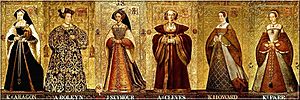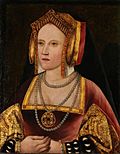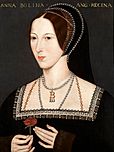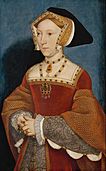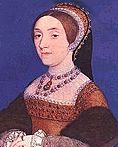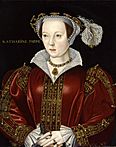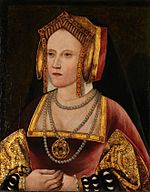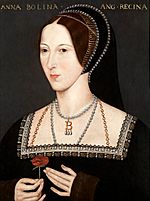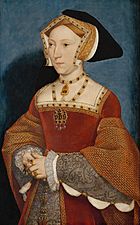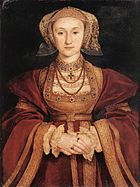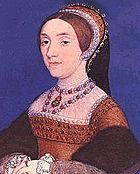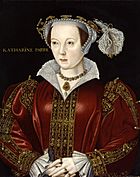Wives of Henry VIII facts for kids
(years of marriage)
"Divorced, beheaded, died
Divorced, beheaded, survived"
(1509–1533)
(1533–1536)
(1536–1537)
(1540)
(1540–1542)
(1543–1547)
The wives of Henry VIII were the six queens married to King Henry VIII of England. He was king from 1509 until he died in 1547.
Legally, Henry had only three wives. This is because three of his marriages were later declared invalid by the Church of England. This process is called an annulment. An annulment means the marriage was never truly legal, unlike a divorce, which ends a valid marriage. Henry wanted an annulment from his first wife, Catherine of Aragon, but the Pope did not agree. Henry also had several mistresses.
Contents
Meet Henry VIII's Wives
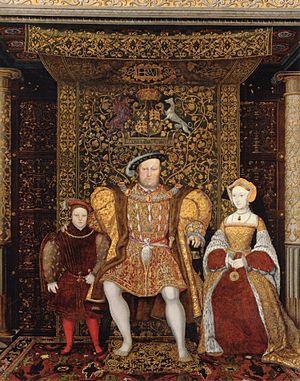
Here are the six women Henry VIII married, in order:
| No. | Name | Marriage Dates | What Happened | Children |
|---|---|---|---|---|
| 1 | Catherine of Aragon | June 11, 1509 – May 23, 1533 | Marriage ended by annulment | Mother of Queen Mary I. She died in 1536. |
| 2 | Anne Boleyn | May 28, 1533 – May 17, 1536 | Marriage ended by annulment | Mother of Queen Elizabeth I. She was executed in 1536. |
| 3 | Jane Seymour | May 30, 1536 – October 24, 1537 | Marriage ended by her death | Mother of King Edward VI. She died in 1537. |
| 4 | Anne of Cleves | January 6, 1540 – July 12, 1540 | Marriage ended by annulment | No children with Henry. She died in 1557. |
| 5 | Catherine Howard | July 28, 1540 – February 13, 1542 | Marriage ended by her execution | No children. She was executed in 1542. |
| 6 | Catherine Parr | July 12, 1543 – January 28, 1547 | Marriage ended by Henry's death | No children with Henry. She died in 1548. |
Henry's first marriage to Catherine of Aragon lasted almost 24 years. His next five marriages combined lasted less than 10 years.
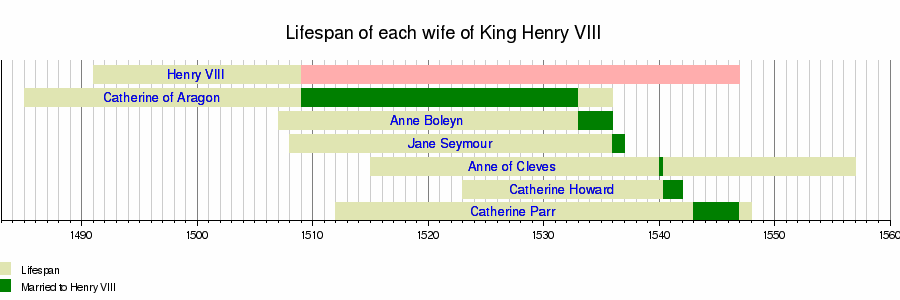
Historian David Starkey studied the House of Tudor royal family. He said that Henry VIII was often a very good husband at the start of his marriages. He was kind and generous, giving his wives land and jewels. He was also very caring when they were pregnant. However, if a wife displeased him, Henry could become very angry. Two of his wives were executed because of his commands.
Royal Children and Family Ties
Catherine of Aragon, Anne Boleyn, and Jane Seymour each had one child with Henry VIII who lived past infancy. These were two daughters and one son. All three of these children later became rulers of England: King Edward VI, Queen Mary I, and Queen Elizabeth I.
Anne Boleyn and Catherine Howard were first cousins. Jane Seymour was a second cousin to both Anne Boleyn and Catherine Howard. Many of Henry's wives worked for another wife before their marriage, often as a lady-in-waiting. For example, Anne Boleyn served Catherine of Aragon. Jane Seymour served both Catherine of Aragon and Anne Boleyn. Catherine Howard served Anne of Cleves.
Catherine of Aragon
Catherine of Aragon (born December 16, 1485; died January 7, 1536) was Henry's first wife. She usually spelled her name with a "K," which was common in England then.
Catherine was first married to Arthur, Henry's older brother. Arthur died in 1502. To allow Catherine to marry Henry, the Pope gave special permission. This marriage happened in 1509, when Henry was 18 and Catherine was 24.
Catherine had several pregnancies. In 1510, her baby girl was stillborn. In 1511, she gave birth to a son, Henry, who died after two months. She had other babies who did not survive. Finally, in 1516, at age 31, she had a healthy daughter, Mary. Catherine hoped for more sons, but she never had another child who lived.
Henry truly loved Catherine at first. But he became worried because he did not have a son to take over the throne.
Henry, who was Catholic, asked the Pope to annul his marriage. He said it was wrong because Catherine had been married to his brother first. The Pope refused. In 1531, Henry separated from Catherine. She was 46, and he was 40. Henry then ordered the top church official in England, Thomas Cranmer, to hold a court. On May 23, 1533, Cranmer declared Henry's marriage to Catherine invalid.
Five days later, Cranmer said Henry was legally married to Anne Boleyn. Henry had already secretly married Anne. This decision caused England to break away from the Roman Catholic Church. This led to the creation of the Church of England.
After marrying Anne Boleyn, Henry sent Catherine away. She never saw Henry or their daughter Mary again. Catherine died alone at age 51.
Anne Boleyn
Anne Boleyn (born around 1507; died May 19, 1536) was Henry's second wife. She was the mother of Elizabeth I. Her marriage to Henry and her execution were big events in the English Reformation. This was a time of major religious and political change in England.
Anne was the daughter of Sir Thomas Boleyn. She was from a noble family. She had dark hair, beautiful features, and a lively personality. Anne was educated in Europe, where she learned French. She worked as a lady-in-waiting for Queen Claude of France.
In 1533, Henry and Anne had a secret wedding. Henry was 42, and Anne was in her late 20s. She soon became pregnant. A public wedding was held in London on January 25, 1533. On May 23, 1533, the church leader Cranmer declared Henry's first marriage invalid. Five days later, he declared Henry's marriage to Anne valid.
Soon after, the Pope took action against Henry and Cranmer. Because of Anne's marriage, the Church of England separated from Rome. It came under the king's control. Anne was crowned Queen of England on June 1, 1533. On September 7, she gave birth to Henry's second daughter, Elizabeth.
Anne did not have a son who lived. Henry grew tired of waiting for a male heir from her. Henry had their marriage annulled. Then, Thomas Cromwell planned for her execution.
Anne was found guilty of serious charges, even though the evidence was weak. She was beheaded on May 19, 1536, when she was no older than 31. After her daughter Elizabeth became queen, Anne was seen as a hero of the English Reformation. Many books and artworks have been made about her.
Jane Seymour
Jane Seymour (born around 1508; died October 24, 1537) was Henry's third wife. She had served Catherine of Aragon as a maid-of-honour. She was also one of Anne Boleyn's ladies-in-waiting.
Jane was the daughter of Sir John Seymour. She was likely born at Wulfhall, Wiltshire. Jane was from a less noble family than Henry's other wives. She could read and write a little. However, she was very good at needlework and household management. These skills were considered very important for women at that time.
Jane married Henry VIII on May 20, 1536, at the Palace of Whitehall, London. This was just one day after Anne Boleyn's execution. Jane was 28, and Henry was 45. About a year and a half later, Jane gave birth to a son, Edward. But she died twelve days later from problems after childbirth.
Jane was the only wife to receive a proper queen's burial. When Henry died, he chose to be buried next to her. This might have been because he loved her, or to show that his son Edward was the rightful heir.
Anne of Cleves
Anne of Cleves (born June 28 or September 22, 1515; died July 16, 1557) was a German princess. She was Henry's fourth wife and Queen of England for only six months in 1540. She was never crowned queen. Henry supposedly called her "a Flanders mare," meaning she looked like a horse.
A famous artist, Hans Holbein, painted Anne of Cleves' portrait. This painting was sent to King Henry so he could decide if he wanted to marry her. Her brother did not let Holbein paint her face directly, so she wore veils. Henry liked the portrait and wanted her to come to England.
When Anne arrived, Henry was not impressed. He complained that she did not look like her portrait. Her previous marriage contract with Francis I, Duke of Lorraine was used as a reason to annul their marriage. Anne did not fight the annulment. She was given a generous payment and Hever Castle, which used to belong to the Boleyn family.
She was called "The King's Sister" and remained a lifelong friend to Henry and his children. Anne of Cleves was about the same age as Henry VIII's oldest daughter, Mary. She outlived Henry and all his other wives. She died on July 16, 1557, likely from cancer. She was buried in Westminster Abbey.
Catherine Howard
Catherine Howard (born around 1521; died February 13, 1542) was Henry's fifth wife. She was queen between 1540 and 1542. She was the daughter of Lord Edmund Howard. Catherine was a cousin to Anne Boleyn and a second cousin to Jane Seymour. Her uncle, Thomas Howard, 3rd Duke of Norfolk, was an important politician in Henry's court. He helped Catherine get a job in the household of Henry's fourth wife, Anne of Cleves. There, Catherine caught the King's attention.
She married Henry on July 28, 1540, at Oatlands Palace in Surrey. This was just 19 days after his marriage to Anne of Cleves was annulled. Henry was 49, and Catherine was still a teenager, probably around 18. Catherine Howard was even younger than Henry VIII's oldest child, Mary I, who was 24 at the time. Elizabeth was 9, and Edward was 3.
On November 1, 1541, Henry was told about her past behavior. Catherine was no longer queen in November 1541. She was executed in February 1542.
Catherine Parr
Catherine Parr (born 1512; died September 5, 1548) was Henry VIII's sixth and last wife. She was queen from 1543 to 1547. Her father was Sir Thomas Parr. Through her father, Catherine was related to King Edward III. She was Henry's third cousin, once removed, and also his fourth cousin, once removed.
Catherine helped bring Henry's royal household together as a family. She wanted to show that the royal family was united and strong. Perhaps her most important achievement was convincing Henry to pass a law, the Third Succession Act. This law confirmed that both Mary and Elizabeth could inherit the throne. This was important because they had been declared illegitimate earlier. When this law was passed, Catherine Parr was 31, Mary was 27, Elizabeth was 10, and Henry was 52.
Henry trusted Catherine so much that he chose her to rule England as Regent while he was fighting a war in France. If he had died, she would have continued to rule until nine-year-old Edward was old enough.
Catherine Parr holds a special place in history because she had four husbands in total, more than any other English queen. Henry was her third husband. She had been a widow twice before marrying Henry. After Henry died, she married Thomas Seymour, who was King Edward VI's uncle. She had one child with Seymour, a daughter named Mary. Catherine died shortly after Mary was born, at age 35 or 36. What happened to Lady Mary is not known, but she is thought to have died in childhood. Catherine Parr is buried at Sudeley Castle in Winchcombe.
See also
 In Spanish: Esposas de Enrique VIII para niños
In Spanish: Esposas de Enrique VIII para niños


